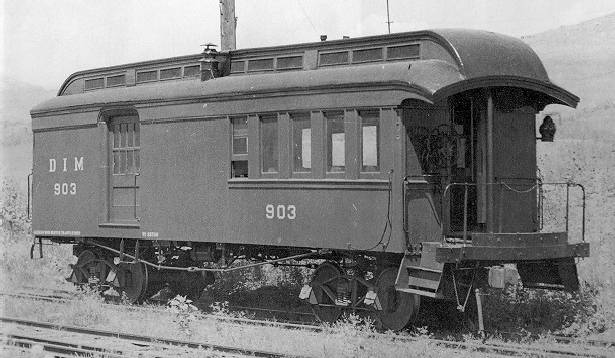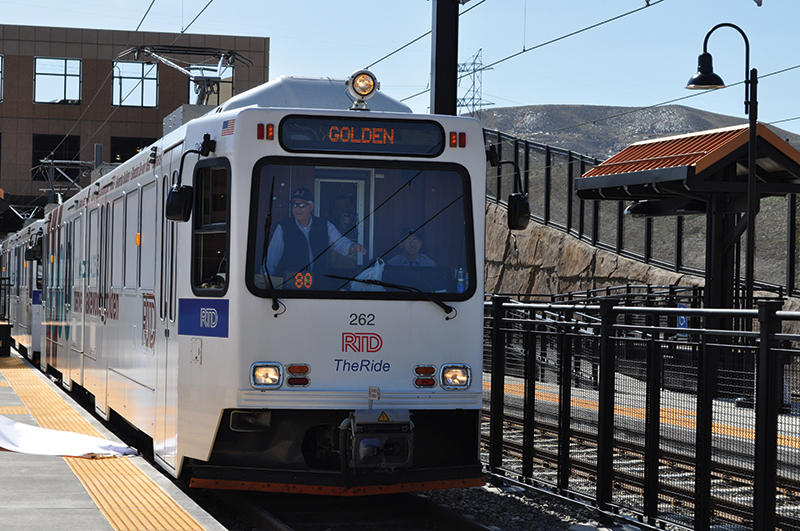-----
 |
| Ex-New York El, now DL&G No. 1, hauling a promotional train over what is now Federal Boulevard in Denver. (Golden History) |
The first railroads to reach Golden, Colorado from Denver was the Denver, Lakewood, & Golden (DL&G) in 1893. Built as a standard gauge steam and electric road, it was chartered in October 4, 1890 but did not operate until 1893 and used second-hand equipment from the New York Elevated to haul its trains. The electric part of the railroad only went as far west as the Denver city limits. It would run five trains a day until 1896, when the line north of Golden was washed out and rendered unusable. To make things worse, the DL&G saw heavy financial losses following the disaster and end up foreclosed on May 19, 1904. Samuel Newhouse would be the new owner of the system and under the new name, Denver & Intermountain Railway (D&IMR), it was then sold to the Denver Tramway system.
 |
| A Denver & Northwestern Railway coal train, showing off a home-brew "power" car on a Perley truck design, 1900s. (Denver Library) |
Around the same time the D&IMR was sold, the Denver & Northwestern Railway was built to haul coal from the mines in nearby Leyden to the Tramway's Denver power plant in 1903. Narrow gauge tracks also reached Golden a year later, just in time for the Tramway to scoop up the D&IMR from Mr. Newhouse. Over the next five years, Denver Tramway would set about not only electrifying the line to Golden for its narrow gauge cars, but repurposing the standard gauge tracks for its own use. In 1909, the 13-mile Route 84 from Denver to Golden via Barnum, Morningside, and Wymans Junctions was inaugurated.
Despite the standard gauge line opening in 1909, and with Tramway's narrow gauge cars operating on the 83 Line north via Clear Creek Junction, the first seven cars would not arrive until 1911 from the local Woeber Auto Body and Manufacturing Company. These unique cars would be the only interurbans built in the state of Colorado, and were originally outfitted with oil stoves on either end to help keep warm in the chilly Rocky Mountain Winters. Unusually for an Interurban, the trains were never multiple-unit capable, so single cars would traverse the 13 miles even at peak rush hour.
 |
| D&IMR 23 and 24, part of the new order from Woeber Auto Body. Notice the absence of couplers. (Golden History) |
 |
| D&IMR freight motors at West 39th and Utica in Berkeley, Denver, possibly passing a carhouse, 1945. (Denver Library) |
 |
| An ex-Colorado & Southern combine on standard gauge trucks, used as a caboose on the D&IMR (Midcontinent Railroad Museum) |
D&IMR also operated a freight service using Baldwin-Westinghouse "Class D" freight motors to work the Rubey clay mines, interchanging at Golden with the Colorado & Southern (who operated the competing Denver & Interurban). Colorado & Southern would also provide old narrow gauge cars for use as cabooses. This line would open in 1911, with the Baldwins being delivered in the 1920s, and would constitute 95% of the Denver Tramway's freight revenue, while the other 5% came from sugar beets. D&IMR teamed up with the local Great Western Sugar Company in 1917 to challenge farmers in the Lakewood Area to grow sugar beets, promising to build an automatic freight car dump on their property if 500 acres could be planted. The two railways hoped for 600-700 acres planted, but ended up with 2,000 acres.
When the fare drama reached the D&MIR in 1911, which had Denver Tramway ignoring their charter to raise fares and citizens demanding they keep it at 5 cents, a few Lakewood passengers decided to protest on the interurban by only paying the 5 cent fare. They were soon met at the County Line by the Tramway's president and Deputy Sheriff, who denied them passage unless they paid properly. Two passengers were arrested, others were thrown off, and the rest left voluntarily. The line was left alone during the massive streetcar riot of 1920.
 |
| Car 25 in the later yellow scheme, running through Golden, Colorado, 1940s. (Don Ross) |
1913 would bring a couple of weather calamities to the D&IMR, starting in August when Car 25 was caught in the middle of a vicious rainstorm. Leaving Golden, the car just escaped a bridge being knocked out by the flooded Kinney Run, when another bridge ahead was suddenly washed out as well. Passenger Michael Sweeney was able to alert the motorman and stop the car on Jackson Street, leaving the interurban marooned but safe until the waters died down.
The other weather calamity arrived in December 4 that same year, when another car ended up stuck at Wright station in the middle of rural Lakewood. After the oil in the stoves had gone out, a passenger named Arthur "Jack" Frost was able to brave the high snow drifts and reach a farmhouse for a sack of coal. Feeling warmed, the next day the car was able to make it to the next biggest station, all while passing 12-foot high snowdrifts.
 |
| D&IMR Car No. 819 at the Central and Interurban Loop on 15th and Arapahoe, bound for Golden. (DenverUrbanism) |
After the shakeup in the 1920s, D&IMR would receive new steel interurbans from Woeber Auto Body. These cars, 818 and 819, were part of a new 800-series class developed by Denver Traction shops and the only new standard gauge passenger cars the interurban would be getting.
The rest of the D&IMR's life would be of highs and lows, starting with the Devinny (Lakewood-Wadsworth) Station collision, where motorman W.F. Alexander entered the mainline while another train was still on the main. Three were seriously injured, but thankfully no deaths. Another event that same year was the Welch family being struck at a grade crossing by a car driven by their friend, T.R. Grover. Charles Welch Jr. and wife died instantly, near the gates of the Welchester estate. Grover was given months of leave to recuperate.
The 1940s would be the last period of major expansion for the D&MIR, as wartime necessities demanded the new Remington Arms Factory and the adjoining Remaco Spur in 1941. President Franklin Delano Roosevelt himself would ride the D&IMR in 1943, on a surprise inspection to the factory. Postwar, the railroad suffered as car and bus travel expanded, and on June 4,1950, the last train on the 84 Line operated from Golden to Denver. The Rubey Clay Mine freight service would continue until March 15, 1953, when it was taken over by the Associated Railroads and all points west of Remaco Junction was shut down.
 |
| RTD light rail vehicle No. 262 on the opening day of the W Line, 2013 (City of Golden) |
Today, the original Denver & Intermountain Railway "84" line is run by the Regional Transportation District as the "W Line", reactivating the main line after a combined 96 years of zero operation. The "West Rail Line" (its construction name) was also able to fulfill a goal of the original interurban by connecting directly to Denver Union Station in 2013. It continues to operate today between Golden Government Center and Union Station, with Remaco Junction now called "Federal Center." The old D&IMR tracks to Sheridan Blvd in Denver were also used by the Platte Valley Trolley, but this stopped in 2007 due to the "Fastracks" light rail project.
 |
| Gomaco-built Platte Valley trolley, which started in 1989, showing off its new people-catcher. (Tripadvisor) |
As for surviving pieces of equipment, the only car to survive into preservation was D&IMR 25. Under the care of the Rocky Mountain Railroad Club Historical Foundation, No. 25 underwent a 22-year restoration starting in 1988 and ended up on the State and National Register of historic places. The car is currently stored at Denver Federal Center, where it occasionally runs on the old Remington Arms Factory track.
 |
| Denver & Intermountain No 25 in operation, with the RTD W Line behind it. (City of Lakewood) |
-----
Thank you for reading today's Trolley Tuesday post! It was definitely a challenge trying to separate the Intermountain from the Interurban, but I think I did it justice. As usual, if you want to follow myself or my editor on twitter, or just want to buy a shirt, follow the links available! See you on Thursday when we cover the Kite Route!


No comments:
Post a Comment